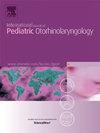Analysis of the therapeutic effect of EarWell ear orthotics on elderly children with congenital ear deformities within 98 days
IF 1.2
4区 医学
Q3 OTORHINOLARYNGOLOGY
International journal of pediatric otorhinolaryngology
Pub Date : 2025-02-01
DOI:10.1016/j.ijporl.2025.112236
引用次数: 0
Abstract
Objective
To observe the efficacy of EarWell ear orthotics in treating congenital ear deformities in older children (≥7 weeks) within 98 days.
Method
A retrospective study was conducted on 58 infants (69 ears) aged 7–14 weeks after birth. Divided into three groups: A (7–9 weeks old, 26 ears), B (10–12 weeks old, 23 ears), and C (13–14 weeks old, 20 ears). Analyze the differences in treatment time, effective rate, six-month recurrence rate, and incidence of complications among three age groups.
Result
Age group A had the shortest treatment time (25.13 ± 3.28d) and the highest effective rate (84.61 %), while age group C had the longest treatment time (48.35 ± 7.64d) and the lowest effective rate (60.00 %), with statistically significant differences (p < 0.05); The six-month recurrence rate and incidence of complications in the A age group were lower than the other two groups, and the difference was statistically significant (p < 0.05); The recurrence cases in the three age groups are mainly concentrated in the cup ear and the prominent ear.
Conclusion
EarWell ear orthotics can still be chosen for morphological correction of congenital ear deformities in children aged 7–14 weeks. However, the effectiveness of treatment may be affected by the age of treatment and the type of malformation. The older the age of treatment, the lower the effectiveness of orthosis treatment, the longer the treatment time, and the higher the probability of complications. Cup ears and prominent ear over 7 weeks old have a higher recurrence rate after treatment, and it is recommended to correct them as soon as possible.
求助全文
约1分钟内获得全文
求助全文
来源期刊
CiteScore
3.20
自引率
6.70%
发文量
276
审稿时长
62 days
期刊介绍:
The purpose of the International Journal of Pediatric Otorhinolaryngology is to concentrate and disseminate information concerning prevention, cure and care of otorhinolaryngological disorders in infants and children due to developmental, degenerative, infectious, neoplastic, traumatic, social, psychiatric and economic causes. The Journal provides a medium for clinical and basic contributions in all of the areas of pediatric otorhinolaryngology. This includes medical and surgical otology, bronchoesophagology, laryngology, rhinology, diseases of the head and neck, and disorders of communication, including voice, speech and language disorders.

 求助内容:
求助内容: 应助结果提醒方式:
应助结果提醒方式:


